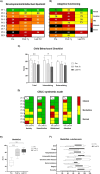Positive Clinical, Neuropsychological, and Metabolic Impact of Liver Transplantation in Patients With Argininosuccinate Lyase Deficiency
- PMID: 39776112
- PMCID: PMC11706762
- DOI: 10.1002/jimd.12843
Positive Clinical, Neuropsychological, and Metabolic Impact of Liver Transplantation in Patients With Argininosuccinate Lyase Deficiency
Abstract
Liver transplantation (LTx) is increasingly used in Urea Cycle Defects (UCDs) to prevent recurrent hyperammonemia and related neurological irreversible injury. Among UCDs, argininosuccinate lyase deficiency (ASLD) has a more complex phenotype than other UCDs, with long-term neurocognitive deficits. Therefore, the role of LTx in ASLD is still debated. The impact of LTx on nine patients with early-onset ASLD was assessed through pre- and post-LTx clinical, neuropsychological, MRI and biochemical evaluations. After LTx, no episodes of metabolic decompensations were reported. Neuropsychological evaluations documented significant improvement in cognitive/developmental functioning especially in patients transplanted in early childhood. Improvements were also highlighted in daily living skills and emotional-behavioral problems, with a reduction in attention disturbances and somatic complaints. Movement disorders resolved after LTx in patient transplanted in early childhood. Any patients developed epilepsy with stability of EEG alterations after LTx. A positive effect of LTx on other disease-related outcomes such as growth, diet, medications, hospitalizations, and long-term ASLD-related complications was highlighted. The primary biomarker argininosuccinic acid dramatically reduced in plasma after transplantation with a decreasing trend in CSF at long-term follow-up. Moreover, health-related quality of life improved after LTx, especially when assessed through MetabQoL, a tool designed for intoxication diseases such as ASLD. In conclusion, our study showed a global beneficial impact of LTx in early-onset ASLD patients to avoid episodes of hyperammonemia, and improve neurocognitive outcome, adaptive and behavioral deficits when performed in early childhood with a dramatic benefit in terms of quality of life.
Keywords: Argininosuccinate lyase deficiency; argininosuccinic acid; developmental/intellectual quotient; liver transplantation; quality of life.
© 2025 The Author(s). Journal of Inherited Metabolic Disease published by John Wiley & Sons Ltd on behalf of SSIEM.
Conflict of interest statement
The authors declare no conflicts of interest.
Figures

 ), liver transplantation and long‐term follow‐up in nine ASLD patients. Neonatal hyperammonemia (
), liver transplantation and long‐term follow‐up in nine ASLD patients. Neonatal hyperammonemia ( ) management required neonatal intensive care unit and 4/9 patients also required dialytic treatment (CVVH *).
) management required neonatal intensive care unit and 4/9 patients also required dialytic treatment (CVVH *).




References
-
- Häberle J., Burlina A., Chakrapani A., et al., “Suggested Guidelines for the Diagnosis and Management of Urea Cycle Disorders: First Revision,” Journal of Inherited Metabolic Disease 42, no. 6 (2019): 1192–1230. - PubMed
-
- Eldredge J. A. and Hardikar W., “Current Status and Future Directions of Liver Transplantation for Metabolic Liver Disease in Children,” Pediatric Transplantation 28, no. 1 (2024): e14625. - PubMed
-
- McKiernan P. J., Ganoza A., Squires J. E., et al., “Evolving Trends in Liver Transplant for Metabolic Liver Disease in the United States,” Liver Transplantation 25, no. 6 (2019): 911–921. - PubMed
Publication types
MeSH terms
Substances
Grants and funding
LinkOut - more resources
Full Text Sources
Medical

